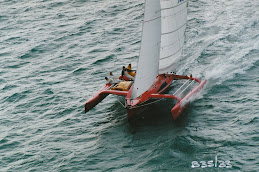

Fairing the Trimaran main hull.
The west system fairing involves applying a light weight epoxy resin fairing compound with a notched plasters float, leaving lots of raised lines spaced about 50mm and about 3-4mm higher than the hull surface to cure hard. If the hull is not very fair then the height of the raised lines will be need to be increased. Once they were cured then I used a 1M long homemade long board with sanding paper attached to it and carefully sanded the tops of the raised lines of fairing down so that the where the overlaps in the glass were, the lines would be about 0.5mm and roughly about half the distance of the long board the raised lines would be deeper depending on how well the hull was made, and then progressively less height the further away from the fibreglass overlap you went. Essentially a fair surface is created across the tops of the railway lines.
With a flat float using the prepared raised lines as guides, I towelled on the fairing, filling in the spaces in-between the raised lines. I learnt not to play with the fairing too much as it only made the finish worse. Once the fairing was applied I let it cure, and then got the long board out again this time with finer grit to carefully sand the filler down to the railway lines, taking care not to take too much of them as that would essentially produce a hollow. After this coat cured, there were a few small local areas that need little more attention, but nothing much.When the fairing was finished the hull could then be turned over up right so that the temporary mould frames could be removed.
The west system fairing involves applying a light weight epoxy resin fairing compound with a notched plasters float, leaving lots of raised lines spaced about 50mm and about 3-4mm higher than the hull surface to cure hard. If the hull is not very fair then the height of the raised lines will be need to be increased. Once they were cured then I used a 1M long homemade long board with sanding paper attached to it and carefully sanded the tops of the raised lines of fairing down so that the where the overlaps in the glass were, the lines would be about 0.5mm and roughly about half the distance of the long board the raised lines would be deeper depending on how well the hull was made, and then progressively less height the further away from the fibreglass overlap you went. Essentially a fair surface is created across the tops of the railway lines.
With a flat float using the prepared raised lines as guides, I towelled on the fairing, filling in the spaces in-between the raised lines. I learnt not to play with the fairing too much as it only made the finish worse. Once the fairing was applied I let it cure, and then got the long board out again this time with finer grit to carefully sand the filler down to the railway lines, taking care not to take too much of them as that would essentially produce a hollow. After this coat cured, there were a few small local areas that need little more attention, but nothing much.When the fairing was finished the hull could then be turned over up right so that the temporary mould frames could be removed.











